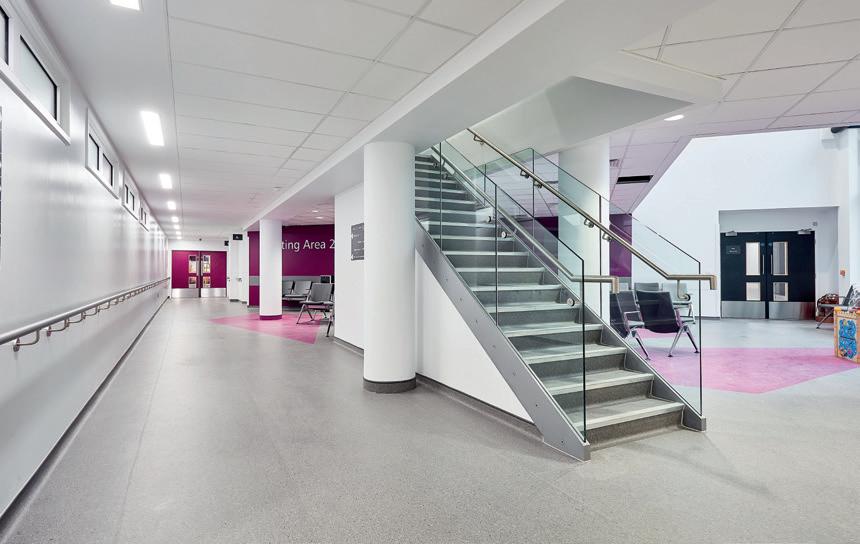
2 minute read
RETROFITTING HEALTHCARE SPACES THE RIGHT WAY
Steve McSorley, Director at Perega, discusses the importance of enforcing a comprehensive retrofitting programme in the healthcare sector and reveals how it is the answer to delivering sustainable buildings in accordance with stringent regulations and rising build costs.
ecent socio-economic events have had a seismic impact on several industries nationwide, and, as 2023 progresses, public sector organisations are taking stock and making plans to weather another turbulent year.
Advertisement
Nowhere have the effects been more acutely felt than in our healthcare system, where our facilities have buckled under pressure from an operational and infrastructural standpoint. With current funding levels deemed inadequate to meet today’s challenges, several hospitals across the country are falling short in capacity and capability. The sudden onset of a recession has raised a further barrier to address the problem.
The recent Autumn Statement has offered some silver linings for healthcare construction, but whether they’re realistic is uncertain. They came in the form of a pledge from Government to the New Hospitals Programme (NHP) and the allocation of more infrastructural investment.
This will, hopefully, foster future growth in healthcare construction projects, and present plenty of opportunities for the structural and civil engineering sectors.
Ambitious targets
The goal of building 40 new hospitals from the ground up by 2030 is a tough one to achieve. With rampant inflation in material and energy costs, updated building standards and a persistent labour shortage, determination can only take you so far.
However, there are ways we can solve the issue long term, and that is by adopting a comprehensive retrofit and redevelopment programme, to deliver highquality, sustainable hospitals within the confines of limited resources.
One quick, but effective, approach is to remediate legacy structural issues across many UK healthcare facilities. One good example is the safety concerns surrounding reinforced autoclaved aerated concrete (RAAC).
A popular material between the 1960s and 1980s, reinforced planks made from RAAC are mainly found in the roofs, floors and walls of NHS buildings. However, it’s now recognised that any reinforcement lacking proper protection becomes extremely susceptible to corrosion due to RAAC’s susceptibility to moisture.
This represents a significant health and safety risk for patients and staff, and with guidelines tightening up across the board, there is now a critical need to guarantee occupant safety, whilst reducing embodied emissions and improving energy efficiency.
Take Hinchingbrooke Hospital in Cambridgeshire, disclosed documents have found the hospital prone to serious structural failures. With the likelihood of RAAC panels collapsing dangerously high, emergency action is required to rectify the matter and remove all panels in question. It’s certainly not an isolated case, with another 20 facilities across the UK vulnerable to this issue.
Fortunately, the solution is a relatively simple and costeffective one. By completely removing those panels and planks and replacing them with more robust materials, we can retrofit these spaces to guarantee that the building is kept safe and secure. Requiring minimal maintenance that, in turn, will free up much needed capital in the long run.
Standardised and sustainable
Retrofitting healthcare facilities, through offsite construction, componentisation and standardisation, also provides a cost-effective method to deliver high-quality, standardised healthcare facilities, with structural components drawn off and pre-assembled to meet individual needs.


Volumetric manufacturing produces reliable, high-quality components, with the potential to effortlessly scale up output, enhancing efficiency and lowering the margin for mistakes.
From a sustainability perspective, the precision of off site and componentisation can significantly reduce material waste and transportation emissions. Allowing contractors and subcontractors to work with agility, but not at the expense of quality.
This not only represents a great opportunity for built environment professionals to significantly contribute to Net Zero 2050 goals, but also helps ensure that projects represent good value for money and achieve good returns on the investment.
Securing the future
To best futureproof and revitalise our healthcare assets, we should be moving towards more agile structural solutions, enhancing and reusing materials where possible, instead of demolishing and starting from scratch. We must also embrace the latest technologies and construction methods to ensure correct delivery on time and on budget.
Adopting a more forwardthinking approach to design and construction can achieve shortand long-term ROI, saving time, reducing waste and shrinking our carbon footprint. Ultimately, this will deliver a safe and sustainable future for our public sector healthcare system.









